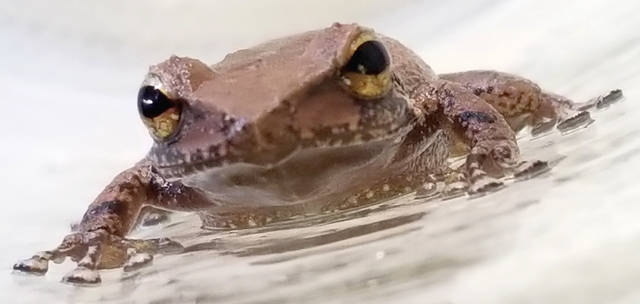LIHUE — Since September, six coqui frogs have been captured in Kapahi, rousing the attention of invasive species groups dedicated to keeping them off of Kauai.
And they’re not the only invasive frogs being captured on the east side of the island — a total of eight coqui have been captured in 2018 on Kauai’s east side by Kauai Invasive Species Committee and Hawaii Department of Agriculture.
The latest capture was announced Nov. 23 and responders are asking for community help to monitor the situation and make sure the loud frogs don’t establish a population.
“Capturing more than one coqui at a time in a single location automatically invokes an increased intensity of follow-up, including crew visits and ongoing site surveys, due to
concern about a possible breeding population,” said Tiffani Keanini, KISC project manager.
Keanini continued: “Regular surveys continue for a full year to cover the nine-month breeding cycle of the frog.”
When just one coqui is reported, the process is relatively straightforward: responders catch the frog and dispose of it. But when multiple frogs are reported, Keanini said there’s a different protocol.
“For sites that come up with multiple frogs, the HDOA Plant Quarantine Branch will work with property owners to determine, if possible, the potential origin of an infestation so that we can ensure additional frogs are not inadvertently shipped inter-island and to close any additional pathways for movement of coqui,” Keanini said.
Coqui are small, are usually shades of light and dark brown and have variable patterns on their skin, including a stripe down the middle of the back. Adult frogs measure up to two inches, according to HDOA.
But they are loud.
Native to Puerto Rico, the frogs are noisy, with levels measured up to 80-90 decibels — comparable to the level of noise produced by a lawn mower.
In large populations, such as on Hawaii Island, the noise levels disturb neighborhoods, force residents to use earplugs at night, decrease property values, and usually remain hidden during the day, active at night.
The one-inch frogs populate Hawaii Island at roughly 55,000 per hectare — a unit of area representing 100 ares or 2.471 acres. They have spread out across the island by way of nursery plants, flowers and hitching rides on vehicles.
Coqui have no natural predators or competitors on the island, says the DLNR, and impact ecosystems by consuming huge numbers of insects, which help pollinate plants.
In 2010, there were only a small number of frogs in Honaunau on the Big Island.
“Now there is almost no silence,” said Tyler Deniz, an employee at Ka Ohi Coqui Control in a story in West Hawaii Today.
They likely got to Hawaii on a shipment of plants from Puerto Rico, and that’s the usual story of how they find their way throughout the islands — including how they got to Kapahi.
“Most likely an accidental introduction of stowaway frogs, froglets, or eggs in plants or other materials imported from an infested area,” Keanini said. “However, need to keep in mind that coqui have been captured in a number of non-agricultural materials including old boats and cars; on shipping containers themselves, portable toilets, and pipes, among other things.”
Over the past few months, invasive species responders have been notified of coqui presence by phone calls from residents who heard the coqui calls at night.
After mobilizing to confirm the reports, all reported frogs have been captured thus far and KISC is monitoring the area on a monthly basis for a year to make certain all life stages originally present have been eradicated.
Keanini said the work is a great example of the community joining forces to ensure Kauai is free of the invasive species.
“Going forward, we need to remain vigilant to detect any further frogs that may remain. The community is our eyes and ears and without them, the ability for rapid response is greatly hindered,” she said.
HDOA says coqui aren’t toxic and can be captured using a flashlight to locate the frog and capturing with a jar or by hand. If it’s caught, do not transport the coqui from the area.
Anyone who hears or sees a coqui frog should report it to 643-PEST or 821-1490.
•••
Jessica Else, environment reporter, can be reached at 245-0452 or jelse@thegardenisland.com.



Aloha Kakou,
After experiencing on the Big Island these insanely all night menace to human sleep, and in spite of the fact they are sentient beings…the article fails to mention…kill them all on sight…the first chance to rid them of the island is to kill them and to kill them all.
How? Thoroughly…!
Charlie
Maybe this is when and where GMO ‘d next generation coqui frogs have their VOICE BOX DNA removed from their Genetic Pool…! ! !
Please run an audio clip for those of us who don’t know what to listen for!
Imagine a cross between a bird tweeting and a kid on a squeaky swing that never stops…it’s horrible and even ear plugs won’t stop it
Wouldn’t it be a good idea to at least *reduce* the rooster population on Kauai for the same (silence) reason? I don’t quite understand why they are protected and wake people also.
Aloha Paula,
They are for dinner and adobo…don’t hesitate…during elections there’s 1 in every pot…who said they are protected…Chicken man….?
I live on the big island. I have lots of Coqui frogs. My wifes cat brings them in the house as a “present”.
I also listen to chickens, dogs, cattle horses, mules, donkeys, wild birds, obnoxious vehicle noises,
surf, and what ever.
If you think you live in a quiet world Hawaii is not the place to be.
Just what we need……perfect rent control….
Stop receiving shipments from Puerto Rico! HELLO!!!!!